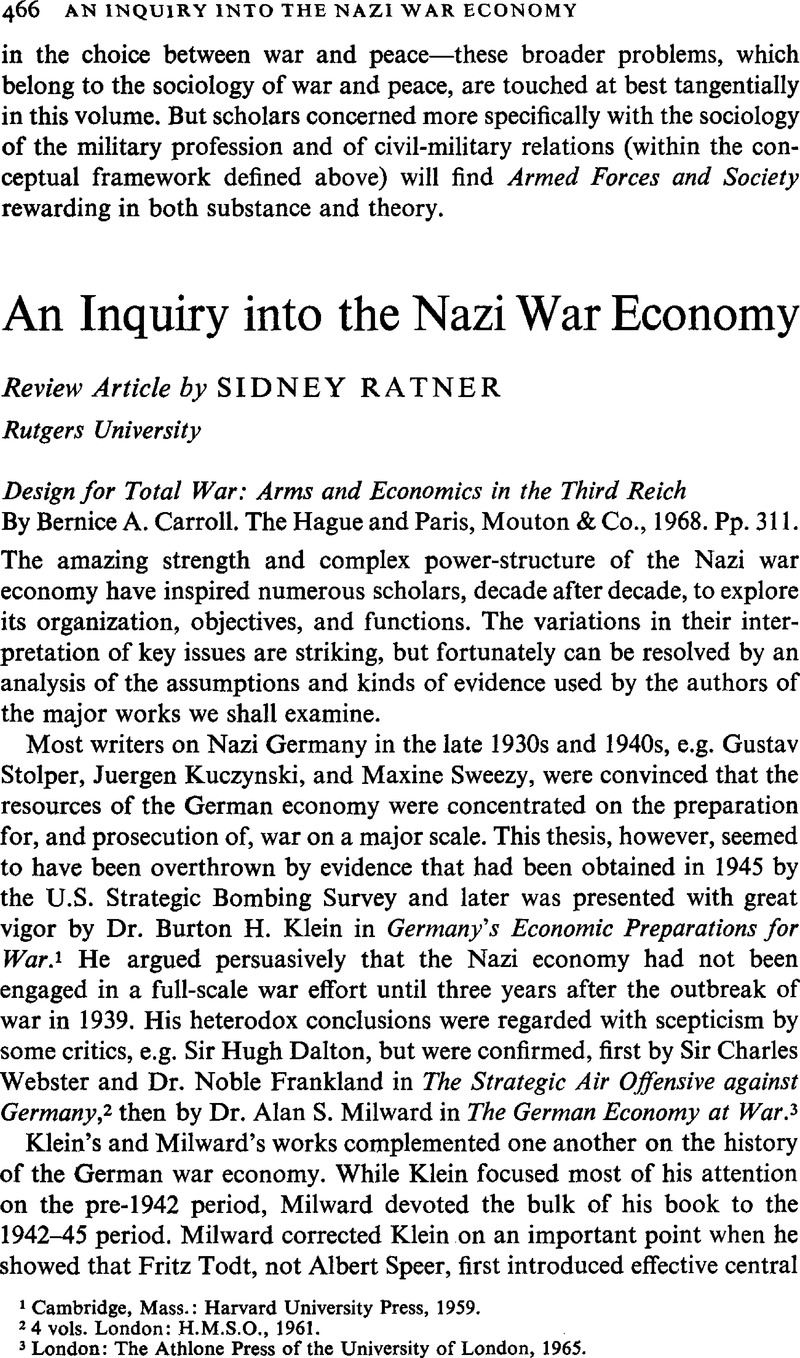No CrossRef data available.
Published online by Cambridge University Press: 03 June 2009

1 Cambridge, Mass.: Harvard University Press, 1959.
2 4 vols. London: H.M.S.O., 1961.
3 London: The Athlone Press of the University of London, 1965.
4 ‘Germany's Preparation for War, a Re-examination’, American Economic Review, XXXVIII (03, 1948), 56–77.Google Scholar Actually Nicholas Kaldor anticipated some of Klein's key points in an incisive essay ‘The German War Economy’, Review of Economic Studies, XIII (1945–46), No. 2, 33–52.Google Scholar So did John K. Galbraith in an insightful, but completely neglected article, ‘Germany Was Badly Run’, Fortune, XXXII (12 1945), 173–8, 196–200.Google Scholar
5 Die nationalsozialistische Wirtschaftspotitik 1933–1939 in Lichte der modemen Theorie (Zurich: Polygraphischer Verlag, 1958), p. 4.Google Scholar
6 Die nationalsozialistiche Machtergreifung, by Bracher, Karl Dietrich, Sauer, Wolfgang, and Schulz, Gerhard (Koln und Opladen: Westdeutscher Verlag, 1960).Google Scholar
7 Op. cit., p. 672. Dr. Sauer, in his discussion of the relationship between Hitler and the German army, presented additional evidence that Hitler‘s entire economic policy was geared toward war and that the Nazi economic recovery rested entirely upon rearmament (pp. 785- 828).
8 Bloomington: Indiana University Press, 1964.
9 Design for Total War, pp. 183–8. The first gives the percentage of the gross national product absorbed by military expenditures in Germany, England, and the United States, 1929–45. The second, the percentage of the G.N.P. absorbed by private consumption in Germany and the United States, 1929–45. The third, the proportion of government expenditures for goods and services absorbed by military expenditures in Germany, 1929–38 and in the United States, 1939–41. The fourth, the proportion of total investment for military purposes as opposed to investment for civilian purposes in the German economy, 1928–38.
10 Op. cit., pp. 189–90, 262–7.
11 Cf. A. J. Brown, Applied Economics (London: Allen & Unwin, 1947), pp. 46–77 and Sidney Ratner, ‘The Economic History of the Second World War’, Journal of Economic History, XII (Summer 1952), 263–70.Google Scholar
12 Military Affairs, X (Spring 1946), 69–80.Google Scholar
13 Cf. May, Ernest R, ‘Nazi Germany and the United States: A Review Essay’, Journal of Modern History, XLI (06 1969), 207–14.CrossRefGoogle Scholar
14 For an exploration of different theories of the Nazi dictatorship, see White, Andrew G. side, ‘The Nature and Origins of National Socialism’, Journal of Central European Affairs, XVII (04, 1957), 48–73;Google ScholarPeterson, Edward N., The Limits of Hitler's Power (Princeton: Princeton University Press, 1969);Google ScholarSauer, Wolfgang, ‘National Socialism: Totalitarianism or Fascism?’ American Historical Review, LXXIII (12 1967), 404–24.CrossRefGoogle Scholar
15 Cf. Galbraith, op. cit., pp. 176–8; Klein, op. cit., pp. 236–8.
16 The Labor Force Under Changing Income and Employment (Princeton: Princeton Univer sity Press, 1958), pp. 16–19, 202–14.Google Scholar
17 Cf. Ratner, op. cit., pp. 266–7.
18 Brown, op. cit., pp. 69–72; Abram Bergson and Simon Kuznets, eds., Economic Trends in the Soviet Union (Cambridge, Mass.: Harvard University Press, 1963), pp. 333f.;Google ScholarJasny, Naum, Soviet Industrialization 1928–1952 (Chicago: University of Chicago, 1961), pp. 382–6;Google ScholarPostan, M. M., British War Production (London: H.M.S.O. and Longmans, Green, 1952), pp. 387–466.Google Scholar